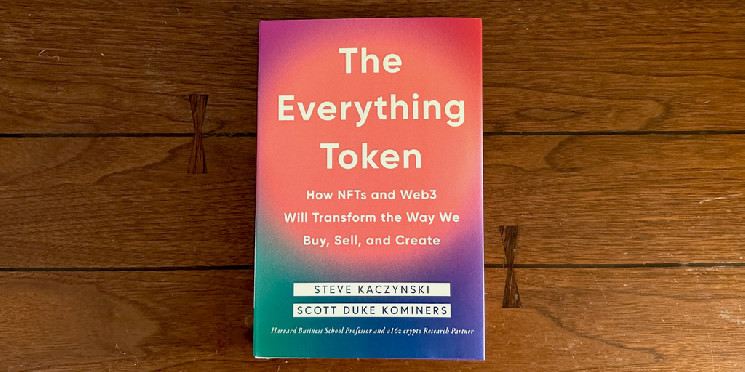“The Everything Token: How NFTs and Web3 Will Transform the Way We Buy, Sell, and Create,” the new book co-authored by Steve Kaczynski and Scott Duke Kominers, is making waves for its unique approach to demystifying NFTs and blockchain for a broad audience.
Since its January 23 release, “The Everything Token” has garnered substantial support from key figures in the NFT community—including Yuga Labs co-founder Wylie “Gordon Goner” Aronow, as the Bored Ape Yacht Club co-creator shared that he purchased 100 copies of the book. (There’s photo evidence, too.)
While NFTs have now spent years in the spotlight, “The Everything Token” appeals to a diverse readership, serving as a resource for late adopters seeking to understand the complexities of blockchain technology and NFTs without feeling overwhelmed. Simultaneously, it provides fresh insights and perspectives that can even engage those already well-versed in the space.
With an onslaught of NFT “experts” flooding the internet with insights and strategies, the need to have credible authors contributing properly vetted information has never been more necessary.
Just ordered 100 copies.
It’s not market manipulation I just have a lot of old teachers I want to flex on.
Congrats again @skominers and @NFTbark pic.twitter.com/dHXlNdGetQ
— GordonGoner.eth (Wylie Aronow) 🍌 (@GordonGoner) January 26, 2024
The two authors are deeply embedded in the Web3 space not only as observers and contributors, but also as authentic voices within the community.
Kominers serves as a research partner at a16z crypto, the crypto arm of venture fund Andreessen Horowitz. He holds a position as a Harvard Business School professor, where he created and currently teaches the school’s first course on NFTs. Kacyznski, on the other hand, is a Web3 entrepreneur who also serves as Head of Community for Starbucks Odyssey. Notably, these authors penned the first article on NFTs for Harvard Business Review in 2021.
Decrypt spoke with the duo to talk about the process of writing the book, its purpose, and further insights into the value it offers to readers of varying expertise levels.
Ascending the “NFT Staircase”
After meeting on the Discord server for NFT project SupDucks and becoming fast friends, Kominers and Kacyznski decided to write a book together and spent the last two years crafting “The Everything Token.”
The purpose, they said, was to onboard latecomers, show the fun of the NFT space, and serve as a thank-you letter to the community that brought them a sense of belonging and friendship. Judging by the 200+ names in the acknowledgments section, they’ve clearly made many friends along the way.
One of the first concepts they came up with, which became a framework for the book, was “The NFT Staircase.” It serves as a metaphorical framework for understanding the essential elements that the authors believe every NFT project should encompass.
These five pivotal factors are Ownership, Utility, Identity, Community, and Evolution, each of which plays a unique role in the journey of an NFT project’s life cycle.
“It was a really powerful exercise to sit and think about,” Kominers said, adding that they used it as a framework to write the book around. “We used a staircase to show the different entities, but use it as a way to explain the path and the direction you can go. “
Kominers explains that the five factors are interconnected. First, owners become essential for providing NFT holders with utility. Then, the higher the utility offered, the greater the likelihood that owners will value and engage with a specific NFT. This increased engagement leads to a deeper integration of the NFT into their identity.
Big congrats to @nftbark for dropping “The Everything Token” w co-author @skominers of @a16z 📚
It’s a brilliant dive into the world of NFTs, shedding light on digital ownership’s significance and offering insights from brands like @Starbucks revolutionizing their approach for… pic.twitter.com/KXieDhU5Oo
— Amanda Terry (@amandaterry) February 2, 2024
Consequently, when an NFT significantly contributes to someone’s identity, it boosts their active participation within the related community. As NFT owners collaborate with fellow enthusiasts, they, in essence, become integral to the NFT’s brand and play a role in shaping its ongoing development.
At its core, the NFT Staircase represents the progression from ownership to utility, where the true “magic” of NFTs unfolds. The authors emphasize that these factors are interconnected, forming a dynamic ecosystem for NFTs to thrive.
A rapidly changing landscape
Akin to the staircase analogy that serves as the book’s thesis, “The Everything Token” begins with foundational explanations, unraveling and defining concepts such as “blockchain” and “NFTs.” However, it quickly propels readers into an exploration of the possibilities this technology offers in domains like art, music, and finance.
The book then delves into intricate subjects, including smart contracts, the democratization of finance, and the future trajectory of digital assets. Even so, while digging into complex topics, “The Everything Token” maintains a lighthearted tone to keep readers engaged.
As the NFT landscape evolves, resources like “The Everything Token” may prove invaluable. But will it be quickly outdated? Kacyznski addresses this, acknowledging that Web3 will develop rapidly to the point where the information presented might change, citing that this is something that they considered while writing the book.
Best seller. Wow.
It’s one thing to be a trending new release, but for several days after its release, The Everything Token held the Best Seller designation in multiple categories.
Thank you to everyone who supported @skominers and me on this book drop.
🧡📙🙏 pic.twitter.com/M1brBL8Mzw
— Steve 🤙 (@NFTbark) February 1, 2024
“We started writing this two years ago, discussing this thing,” he said. “Who knew a Bitcoin ETF was gonna be approved in January of 2024?”
Kacyznski says that’s why they decided to make clear of the challenges, but not harp on them. He expects that the framework will still be useful even a few years down the line, even if the details or examples might have evolved in the time since.
“It is good to historically document,” Kacynzski said “But it’s like this delicate dance of wanting to be completely upfront and honest about the challenges that face this space, but also making sure that we don’t spend too much time on it.”
There are so many technical and social challenges that surround the technology’s ability to reach its full potential, with examples like imperfect infrastructure, regulatory considerations, and issues related to diversity and inclusivity. However, the authors say they present the challenges as hooks to inspire readers to go and explore and not only become better informed about them, but also potentially help build some of the solutions.
Despite persistent challenges and a rollercoaster-like trajectory to the market, the authors’ consensus is that Web3 and NFTs are here to stay.
“There are a lot of the concerns people have because those are very real,” Kominers said of the book’s content. “But we wanted to convey our optimism and make concrete the reasons for our optimism.”
Edited by Andrew Hayward







